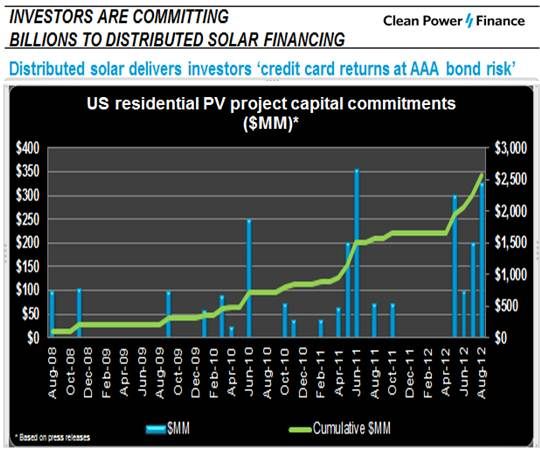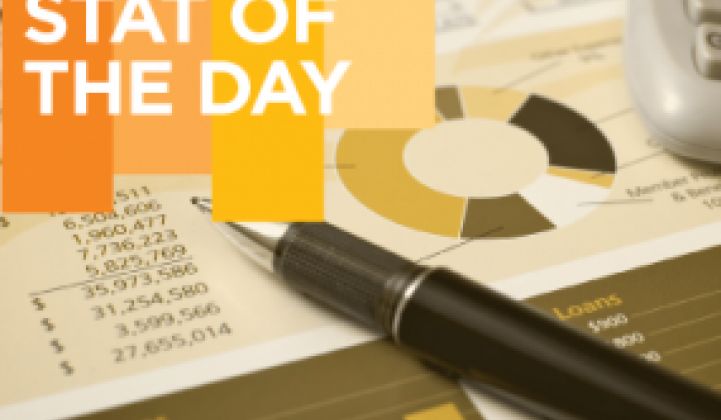In a December 2011 interview, Clean Power Finance CEO Nat Kreamer told GTM his company started selling financing for solar systems in April 2011 and by August of that year was financing, with some 800 solar industry customers and "a handful" of financial partners, “more than a million dollars a day of residential power purchase agreements and leases.”
For August 2012, Kreamer told GTM late last month, “it has been $2 million per day. I just looked at the stats,” he said. “We have $1.9 million and change in applications today. We’re getting demand of $2 million per day or more.” CPF now has 1,350 installer partners and 100 financial partners.
Kreamer had been working on numbers that day for an upcoming presentation. The numbers he saw showed “tremendous market opportunity” and “low penetration rates,” he said. “What you’re seeing is the development of an industry.”
He was reviewing publicly announced capital transactions, compiling the dollar amounts in announced fund sizes, he said, to get an estimate of “the cumulative amount committed to this sector.” It was a huge number.
It started, Kreamer said, “in August in 2008 with a fund from Citi (NYSE: C) for HelioPower. The next transaction is Sunrun in November. And then you don’t see any funds committed during the credit crisis until the fall of ’09. And then you start to see fund volumes increasing. And what you see in the last six months is literally billions of dollars getting committed for residential solar.”
The trajectory is upward, Kreamer said, and “if you look in the last six months at the number of announced transactions and their size, it is pretty awesome.”
Until relatively recently, “You’d see $50 million here, $75 million there,” Kreamer said. Then came the first big transactions. “SolarCity at $280 million, with Google (NASDAQ: GOOG), and Clean Power Finance with $300 million from Morgan Stanley (NYSE: MS),” Kreamer remembered.
“When you look at the fundamental asset today, what you see are great savings for the consumer, good value for the company selling and installing solar, high returns for the investor with a low risk profile.” And consumers, he added, get electricity savings. That, Kreamer said, “is why you are seeing large amounts of capital coming into this sector.”

Kreamer, who founded Sunrun, left it in 2009, and joined Clean Power Finance in 2011, said he sees the third-party ownership of solar sector professionalizing and consolidating.
“Look at the numbers,” he said, listing current market shares. “Sunrun is number one in market share in California at around 30 percent. Number two is SunPower (NASDAQ: SPWR) at 25 percent. Then SolarCity, with 20 percent, and Clean Power Finance, with around 14 percent. No one else had more than 5 percent. After you leave the top four, you get to very small numbers very fast.”
Those numbers, he stipulated, describe market share for finance providers regardless of how the customer is acquired. “There are three different business models about how to acquire deals,” he said, “but the real story is how much capital is getting out, who is getting that capital out and how much they are moving.”
CPF analysis suggests solar will work “for roughly 30 percent or 40 percent of U.S. households,” Kreamer said. “You can build a $100 billion industry in the markets that are open today.”
The numbers he had been studying that day, Kreamer said, put “the cumulative capital committed for financing residential solar at just over $2.5 billion.” There may be more, he said, but it is at least $2.5 billion.”
One of the companies on Kreamer’s list told GTM off the record that his market share and total commitment numbers were accurate, and another said they were possibly slightly off. Kreamer's estimate of the total to date is almost certainly low. Just two of the four companies Kreamer listed in the 2012 top four reported to GTM a total of at least $2.6 billion committed.
But it seems clear that the budding sector is still at least $95 billion short of Kreamer’s $100 billion target.



